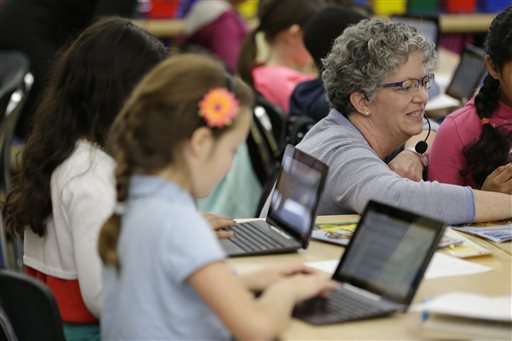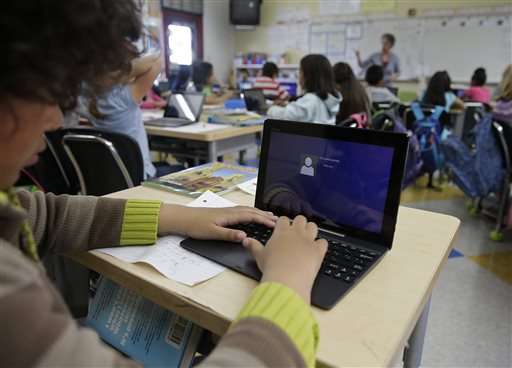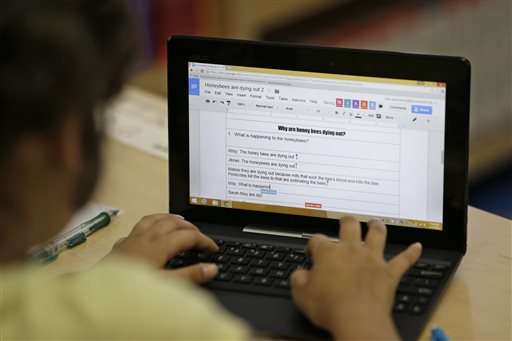As student tests move online, keyboarding enters curriculum

Seven-year-old Ja'Niyah Smith's first-grade class filed into a computer lab at a suburban San Francisco school recently and, as they do every week, practiced using mouses to pop bubbles with a cartoon pickle, catch flies with a frog's tongue and arrange virtual blocks into words.
The students, their legs dangling off their chairs, fell quiet, the silence broken by an occasional "I did it!"
"Computers give us a break, so when we are in class, our minds can be fresh for learning," Ja'Niyah explained as she deftly maneuvered a turtle across a 14-inch desktop screen.
For teachers, administrators and parents in San Pablo—and across the country—the games are a way to help students, sometimes as young as 5, acquire the technology skills they will need to excel on standardized tests that now are being offered online for the first time by a majority of states.
New exams linked to the Common Core state standards are replacing the multiple-choice tests taken with paper and pencils in 29 states this spring. Among the functions even the youngest test-takers must be able to execute are switching between screens, opening drop-down menus, and rearranging words and numbers.
While adults raised in the pre-Internet era might assume today's youngsters are born computer-conversant, educators say hands-on instruction is necessary because the tests require different dexterities than the ones many youngsters pick up playing with smartphones.
"Children can be quick learners when technology is in front of them at school, but knowing very intuitively how to drag and drop or highlight words or even indent a paragraph on a Google doc is not going to come naturally," said Susan Gonzalez, the computer lab teacher at Ja'Niyah's school, Bayview Elementary.

The Common Core tests are given in grades 3-8 and again in high school. The ambitious benchmarks outline what students are expected to learn in math, reading and writing. There are no specific standards for technology, but tech know-how infuses the goals.
The writing standards, for example, call for students to "use a variety of digital tools to produce and publish writing" with the help of adults starting in 1st grade.
By the time they finish 6th grade, they are supposed "to demonstrate sufficient command of keyboarding skills to type a minimum of three pages in a single sitting." In keeping with the Common Core's purpose of preparing students for college and careers, questions on the new computer-enhanced assessments are open-ended instead of multiple-choice.
After the tests were given a dress rehearsal last year in 21 states that are part of the Smarter Balanced Assessment Consortium, one of two national alliances that have developed online tests based on the standards, some teachers expressed concerns that the tests assume a level of digital fluency that may be foreign to children in homes without computers and that the amount of keyboarding involved was excessive for younger students.
Brandt Redd, SBAC's chief technology officer, said he expects fewer concerns this year since teachers have had time to give practice tests and identify any mechanics that need work.
"Technology skills are going to have some impact on student performance, but we have tried to minimize that as much as possible," Redd said, noting that teachers and administrators "were far more nervous" than students, who "weren't at all bothered" by the test's technological demands.

The standards themselves have become politically fraught in some states, and scattered technical glitches and even cyberattacks have hampered the rollout of the online tests.
Morgan Polikoff, an assistant education professor at the University of Southern California, said to the extent the test has motivated school districts to procure more classroom computers and teach children how to use them, it's all for the good.
"I don't think you want to go overboard and spend tons of time on skills that are not useful outside the context of the test, but it's sort of wrong or foolish or short-sighted to not provide some kind of instruction on how to use these tools," Polikoff said. "Yes, typing is a useful skill for taking these tests, but being a fast and accurate typist is a very useful skill period."
Districts that have acquired enough tablets or laptops for regular classroom use say they hope that by next year children will be picking up keyboarding naturally while they are learning the 3 R's instead of working on them specifically for the end-of-year tests.
At Mira Vista School in Richmond, California, fourth-grade teacher Debbie Cruger-Hansen recently started a lesson by asking the class to quietly open their tablets, log in to their school accounts, launch their web browsers and find a Google document on disappearing honey bees.
But first, she had a confession. While reviewing the reading comprehension homework they had posted on a virtual bulletin board the night before, Cruger-Hansen admitted she had been taken aback, amazed at how much they had typed. "My first thought was, 'Oh, their parents did it for them,'" she said with a proud smile.
© 2015 The Associated Press. All rights reserved.

















